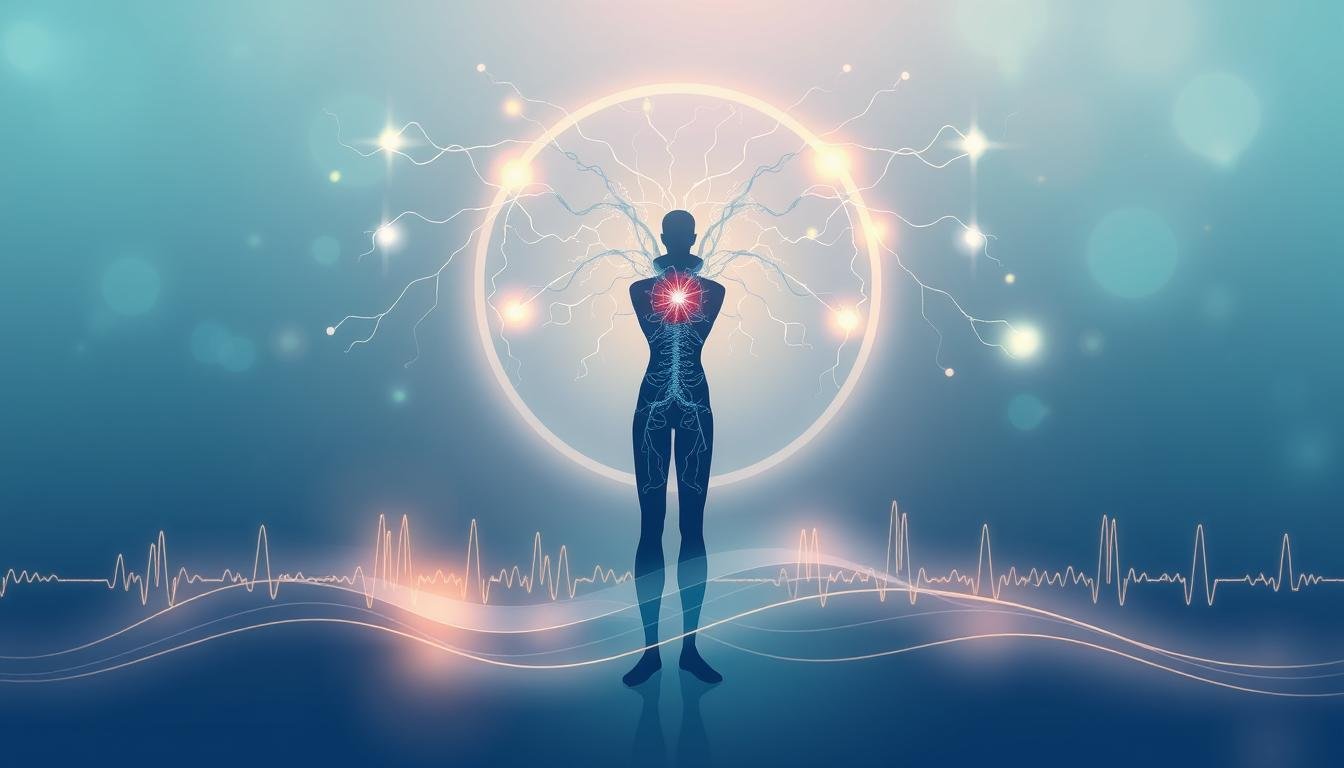Discover the Power of Biofeedback for Better Health
Can you control your body’s functions with your mind? Biofeedback, a powerful mind-body technique, suggests you can. This innovative approach empowers individuals to tap into their body’s natural ability for self-regulation. It offers a path to improved physical and mental well-being.
Biofeedback uses specialized equipment to convert physiological signals into visual or auditory cues. This allows you to gain awareness and control over normally involuntary body functions. From managing chronic pain to reducing stress, biofeedback offers a non-invasive solution for various health concerns.
The mind-body connection is at the heart of biofeedback. By learning to recognize and influence your body’s responses, you can take an active role in your health management. This self-regulation technique has shown promise in treating conditions ranging from migraines to high blood pressure.
As we delve deeper into the world of biofeedback, you’ll discover its potential to transform your approach to health and wellness. Get ready to explore how this fascinating technique works and how it might benefit you.
Understanding Biofeedback: A Mind-Body Technique
Biofeedback is a powerful way to take control of your health. It connects the mind and body, using psychophysiology. This helps people manage their health better.
Definition and Basic Principles
Biofeedback is a method that lets people control their body’s functions. It uses sensors to track things like heart rate and muscle tension. This way, people learn to change these functions, improving their emotional health.
The Science Behind Biofeedback
Biofeedback works on the idea of operant conditioning. It uses rewards and consequences to change behavior. By getting feedback on their body’s functions, people learn to handle stress and pain better.
Types of Biofeedback Techniques
There are many types of biofeedback, each focusing on different body functions:
- Electromyography (EMG): Monitors muscle tension
- Neurofeedback (EEG): Tracks brain wave activity
- Heart Rate Variability (HRV): Measures heart rhythm patterns
- Thermal Biofeedback: Monitors skin temperature
- Electrodermal Activity (EDA): Assesses sweat gland activity
These methods can be used with mindfulness training. This combination helps people control their body’s responses better. It improves their overall health and well-being.
How Biofeedback Works: The Process Explained
Biofeedback is a powerful technique that connects our mind and body. It uses sensors to measure our body’s functions and shows this on a screen. This lets us see how our body responds in real-time.
During a session, electrodes are placed on the skin to track certain functions. These can be brain activity, muscle tension, heart rate, or skin temperature. The data is then shown as visual or sound cues on a monitor.
Patients learn to connect these cues with different body states. They practice Relaxation Techniques to control these functions. These include deep breathing, progressive muscle relaxation, and guided imagery. These practices help patients control processes they usually can’t.
A typical biofeedback session lasts 30 to 60 minutes. Many people start seeing benefits in 10 sessions. The goal is to learn these skills and use them in daily life without equipment.
| Biofeedback Type | Measured Function | Potential Benefits |
|---|---|---|
| EEG (Electroencephalogram) | Brain activity | Improved focus, reduced anxiety |
| EMG (Electromyogram) | Muscle tension | Pain relief, better posture |
| HRV (Heart Rate Variability) | Heart rhythm patterns | Stress reduction, emotional regulation |
Recent research supports biofeedback’s effectiveness. A 2023 study found that virtual biofeedback programs reduced migraines. Another review in 2021 showed that heart rate variability biofeedback lowered blood pressure in several studies.
The use of Brain-Computer Interface technology with biofeedback is creating new possibilities. This combination allows for more precise monitoring and control of brain activity. It could make biofeedback therapies even more effective.
Applications of Biofeedback in Health Management
Biofeedback is a non-invasive method used in health management. It helps people understand their body’s functions in real-time. This empowers them to manage their health better.
Stress Reduction and Relaxation
Biofeedback is great for managing stress. It tracks heart rate and muscle tension. This way, people can learn to control their stress levels.
A 2021 review showed that biofeedback can reduce stress and anxiety. These effects can last up to a year after training.
Pain Management
Biofeedback is effective for pain management. It’s especially helpful for headaches, chronic pain, and fibromyalgia. A 2023 study found that a 6-week biofeedback program helped reduce migraines and muscle tension.
Mental Health Conditions
Neurofeedback, a type of biofeedback, helps with mental health. It’s beneficial for anxiety, ADHD, and depression. It’s also shown to help with uncontrolled seizures.
Physiological Disorders
Biofeedback helps with various physiological disorders. It’s useful for managing hypertension, asthma, and incontinence. A 2021 review found that biofeedback can lower blood pressure in hypertensive individuals.
For urinary incontinence, a 2022 review showed that biofeedback improves symptoms in females. It helps with pelvic floor muscle training.
| Condition | Biofeedback Effectiveness |
|---|---|
| Anxiety | Efficacious (Level 4) |
| Chronic Pain | Probably Efficacious (Level 3) |
| Hypertension | Efficacious (Level 4) |
| Fecal Incontinence | Efficacious and Specific (Level 5) |
Biofeedback Equipment and Technologies
Biofeedback equipment has changed a lot, using new technologies to learn more about our bodies. These tools help us understand and manage our health better.
Common Biofeedback Devices
Today’s biofeedback devices can measure many things at once. For example, NeXus equipment can track brainwaves, muscle tension, and heart rate. It also looks at skin conductance and temperature. This gives a full picture of how our body responds.
Wearable Biofeedback Technology
Wearable biofeedback devices are becoming more popular. They’re easy to use and can track your health all the time. Many come with apps for your phone, so you can see how you’re doing anytime.
Home-Use Biofeedback Systems
Home biofeedback systems make it easy for people to use this technology. They often come with software like BioTrace+, which lets you track your progress. You can also share your data with doctors.
| Device Type | Features | Application |
|---|---|---|
| NeXus-10 MKII | 4 EXG channels, 4 AUX inputs | Multimodal measurements |
| Wearable Devices | Continuous monitoring, App integration | Daily use, Stress management |
| Home Systems | User-friendly software, Data sharing | Self-monitoring, Progress tracking |
Biofeedback technology is getting better all the time. It’s helping us connect research on Brain-Computer Interfaces to real-life uses. These tools help us understand and control our body’s responses, changing how we manage our health.
Benefits and Effectiveness of Biofeedback
Biofeedback is a powerful way to manage health. It uses the mind-body connection for self-regulation. This therapy is non-invasive and helps with many conditions, like high blood pressure, chronic pain, and urinary incontinence.
Studies show biofeedback works well for people of all ages and with different health issues. Kids with ADHD, autism, and headaches often get better. Adults might see a lower risk of heart problems and lower blood pressure.
The success of biofeedback depends on the condition:
| Condition | Effectiveness | Typical Sessions |
|---|---|---|
| Tension Headaches | High | 8-10 |
| Urinary Incontinence | Moderate to High | 10+ |
| Raynaud’s Disease | Moderate | 10+ |
| Anxiety | Moderate | 8-12 |
Biofeedback is safe, with no bad side effects reported. It helps people control their body’s functions. This leads to better health and well-being through self-regulation and mind-body awareness.
Conclusion: Embracing Biofeedback for Holistic Health
Biofeedback therapy is a powerful tool for managing holistic health. It lets people control their body’s functions like heart rate and muscle tension. This is done through real-time electronic monitoring.
By combining emotional intelligence and mindfulness, biofeedback offers a full wellness approach. This makes it a standout choice for those seeking better health.
Studies show biofeedback helps 40 to 60 percent of patients with headaches and migraines. It also helps with stress, anxiety, chronic pain, ADHD, and fibromyalgia. The therapy teaches people to change their behavior, leading to better health and performance.
Looking ahead, biofeedback therapy is a promising direction for healthcare. It combines traditional and alternative treatments in a non-invasive way. By using biofeedback, we can lead a more balanced and self-aware life. Emotional intelligence and mindfulness are key to achieving optimal health.
Source Links
- Biofeedback – Mayo Clinic
- Biofeedback Therapy: Uses and Benefits
- Biofeedback in medicine: who, when, why and how?
- Biofeedback
- How Biofeedback Works
- Biofeedback Trains Mind, Body to Make Changes
- Biofeedback therapy: How it works and uses
- What is Biofeedback | Neuro- and Biofeedback | Mind Media
- VA.gov | Veterans Affairs
- Biofeedback – StatPearls – NCBI Bookshelf
- Professional Biofeedback and Neurofeedback Systems
- Professional Biofeedback Systems
- Biofeedback devices | NeXus – Mind Media USA Inc.
- Biofeedback Information | Mount Sinai
- Biofeedback Therapy: Control Involuntary Actions in Your Body
- Enhance Wellbeing with Biofeedback Therapy
- Embracing The Power Of Biofeedback Therapy – FasterCapital
- Biofeedback Therapy: Benefits, Methods, and Applications








